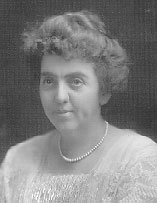Do you know which Iowa State University buildings or campus locations are named for women? This edition of Stories from the Plaza features three women whose service to Iowa State led to the naming of a residence hall and two residence hall houses in their honor.
More than 3,800 women have been honored in the Plaza of Heroines, located in front of Carrie Chapman Catt Hall on Iowa State University’s central campus. To purchase a brick or a paver to honor a heroine in your life, fill out the online order form or email the Carrie Chapman Catt Center for Women and Politics at cattcntr@iastate.edu to request an order form. To add or edit a narrative or photograph in the profile of a woman you have previously honored on the plaza, email the Catt Center or mail your submission(s) to 309 Carrie Chapman Catt Hall, 2224 Osborn Drive, Iowa State University, Ames, IA, 50011-4009.

Iza A. Merchant
Iza A. Merchant
Merchant House in Elm Hall is named for Iza A. Merchant, who taught English, served as Iowa State’s first director of social life, and helped organize various university and community groups during her 35 years at Iowa State.
Iza Marie (White) Merchant was born on May 28, 1901, in Durango, Colorado. She graduated from Colorado State University in 1924 with a Bachelor of Science degree in home economics and from Iowa State in 1928 with a Master of Science in English.
Merchant was an instructor in home economics at Fort Lewis College in Durango, Colorado, from 1924 to 1925. She also coached girl’s athletics and was the first president of the Durango Business and Professional Women’s Club in 1925.
On December 25, 1925, she married Ival Arthur Merchant, a faculty member in Iowa State’s Department of Veterinary Hygiene who later became dean of the College of Veterinary Medicine.
Merchant was an English instructor at Iowa State from 1927 to 1929; secretary of the Committee on English from 1929 to 1930, and the director of social life at Iowa State University from 1930 to 1935. She was also active in community affairs and was widely known for her work with veterinarian’s wives’ organizations.
Merchant was honored on the Plaza of Heroines by Nancy Lysen.

Maria M. Roberts
Roberts Hall is named in honor of Maria M. Roberts, who served in many capacities as a member of the ISU faculty for 52 years and who helped establish Iowa State’s first Student Loan Fund.
Roberts was born in Dunlap, Iowa, on June 29, 1867. She graduated from Iowa State College in 1890. While at Iowa State, she joined the Pi Beta Phi sorority and was the first president of the local YWCA.
One year after graduating, Roberts was offered an instructorship in mathematics at Iowa State. Over time she was promoted from instructor, assistant professor and associate professor to full professor. She became assistant dean of Iowa State’s junior college in 1908 and its dean in 1920. In 1918 she and Julia Trueman Colpitts published the first edition of “Analytic Geometry,” a leading textbook of that time.
In 1933 Roberts was made dean emeritus of the college and chairman of the Student Loan Fund. The class of 1890 presented $5,000 to establish a student loan fund and one of the women’s dormitories was named Roberts Hall in her honor.
At her 50th class reunion, President C.E. Friley conferred upon her the degree of honorary doctor of laws.
Roberts was honored on the Plaza of Heroines by Barbara Dewell Wood and Sam Hamilton.
Winifred R. Tilden
Tilden House in Eaton Hall is named for Winifred R. Tilden, who founded Iowa State’s physical education program for women and was associated with it from 1904 to 1944.

Winifred R. Tilden
Tilden served on a number of national physical education committees. She was a pioneer in advocating for women’s competitive sports and introduced them at Iowa State. She also developed a curriculum of developmental and corrective gymnastics. She introduced the May Day Pageant and May Pole dances in 1911, which became a part of Veishea after 1922.
In 1918 and 1919, Tilden took leave from Iowa State to direct a national Y.W.C.A-sponsored recreational program in a French nurses’ camp.
In 1925, she presented plans for a new women’s physical education building at Iowa State, and in 1941, the building that is the south unit of today’s Physical Education building was dedicated.
Tilden was honored on the Plaza of Heroines by George McJimsey, Elizabeth Hake Colbert, Robert McJimsey, Josephine B. Leffler, and Farwell Brown.